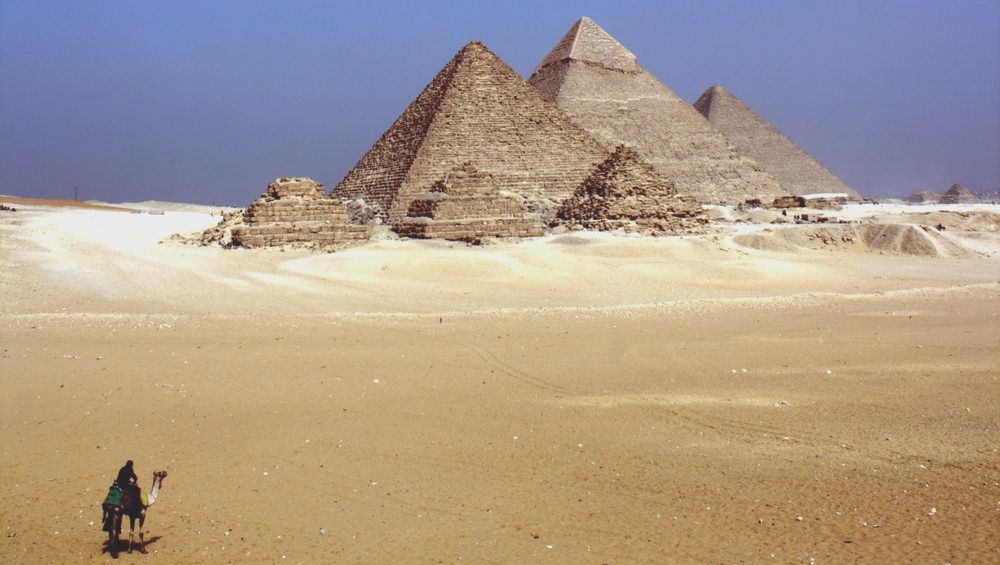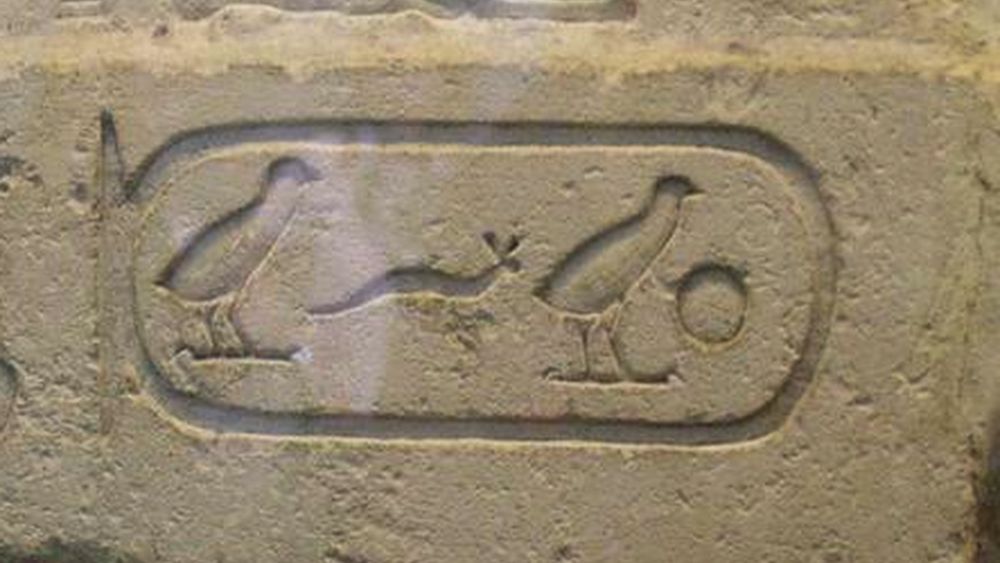The Giza plateau hosts three large pyramids and several ancillary pyramids. The three main pyramids are, in order of size and age:
- The pyramid of Khufu
- The pyramid of Kafra, son of Khufu
- The pyramid de Menkaure, grandson of Khufu
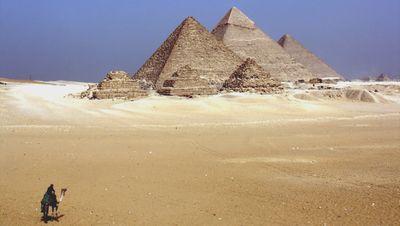
The three pyramids of Giza
These three Pharaohs reigned during the IVth Dynasty, in the middle of the 3rd millennium. These are their graves. But this knowledge is not as solid as one would like to believe. We have very little information to attribute to each his pyramid, and if these assignments are now obvious we could one day have a surprise, if the Egyptologists of the future discover facts that would be likely to call into question this scheduling.
Who built the great pyramids of Giza?
Nowadays, there are so many studies of the pyramids on the Giza plateau that we can be sure that the architectural features of the Great Pyramid are contemporary with those of the other "Memphite" pyramids, with the notable exception of wells and some other minor features of the building. But in spite of the little information that one has it is assured today that it is about constructions of the pharaohs of the IVth dynasty.
The first solid proof of the association between the pyramids and pharaohs of the Fourth Dynasty comes from the "inventory stele" found between the legs of the Sphinx. Although it is widely regarded as a production of a later period it makes the association between Khufu and Giza. There is also a lot of local archaeological evidence (cartouches and statues), which supports the thesis of a relationship between Giza and the pharaohs of the Fourth Dynasty. Added to the "career markings" found in the dump chambers above the chamber of the Kings, it is reasonable to conclude that the Giza complex was essentially built by the pharaohs of the Fourth Dynasty.
Evidence of the activity of the pharaohs of the Fourth Dynasty in Giza
Archeology has brought us numerous proofs of the activity of the pharaohs of the Fourth Dynasty at the Giza site. You must know that finding a cartouche of a pharaoh engraved in the stone of a site is not proof that this site was designed and built by this pharaoh, but when there is a plethora of cartridges and that these are found essentially in only one site, there are strong presumptions for that to be the case.
Here are some proofs:
- Snefrou, father of Khufu: His name was found on a bowl
- Hetepheres, mother of Khufu: Inscription of his name found in a pit and on a pyramid satellite of the great pyramid
- Khufu: His name was found in the dump chambers above the chamber of kings and on several blocks of the Great Pyramid. On the "inventory stele" Khufu calls the great pyramid the house of Isis.
- Kafra: His statue was found in the temple of the valley, with more than 400 figurines, a bowl and a clubhead in the temple east of the pyramid.
- Djefre: A cartridge found on the roof of the pit containing the solar barge, next to the central pyramid.
- Menkaure: A cartridge found in the third pyramid.
- Shepseskhaf: A cartouche found at the shrine of Kafra.
- Khentkaues: Grave grave between the pyramid of Khafra and the road of Menkaure.
In conclusion, it must be remembered that the cartouches of most of the kings of the Fourth Dynasty were found at Giza, and that the great pyramid contains that of Khufu, which tends to prove that the plateau of Giza is indeed a constuction of this dynasty.
Presumed builders of the Great Pyramids of Giza
What is really controversial in the attribution of the paternity of the pyramids is the interpretation that one makes of it. One of the few other written references to Khufu is on the "inventory stele", discovered in Giza in the 1850s. This engraved stone commemorates Khufu's restoration of a small temple near the pyramid, and indicates that the sphinx the sphinx temple, and probably the great pyramid itself, already existed in its day. The stela is written with a later style at that time and although some Egyptologists consider it to be a copy of an original of the 4th Dynasty, it is often accepted that it is an original Sientian production. In any case, this contradicts the idea that the Sphinx was built by Khafra, who reigned after Khufu.
Egyptologists currently think that Hemiounou (2570 BC) is the architect of the Great Pyramid. He was the son of Nefermaat, a relative of Khufu. Archaeologists have found mentions of Hemiounou with titles that can be translated roughly "master of works" and "vizier". His tomb is near the pyramid of Khufu and contains reliefs of his image. Some stones of his mastaba are marked with dates referring to Khufu's reign.
For the second pyramid, that of Khafra, one can quote Petrie "The only proofs are the pieces of a bowl and a clubhead with its name found in the temple (in the east) of this pyramid". "Statues of Khafra were found nearby, but Khafra, whom Petrie thought he had ruled from 3908 to 3845 BC was, like Khufu and Mykerinus, also revered later, and there is now no way of saying whether objects and statues bearing his cartouche are products of the age of the pyramid or of a later era.
Here is what William R. Fix says about the third pyramid: "The third pyramid was attributed to Menkaure only because Herodotus and Diodorus Siculus attributed them to it and because the name" Mykerinus "was found written to the red painting on the ceiling of a chamber of the three pyramids annexes, those south of this third pyramid (Edwards, The Pyramids of Egypt, page 120) No name of this kind was found in the third pyramid it It is very likely that the small pyramid is not contemporary with the third pyramid "
The lack of evidence concerning the identification of the builders of the Giza Pyramids explains why Egyptologists were forced to recognize that beyond the traditional association between the Giza complex and the pharaohs of the Fourth Dynasty, there are very little evidence that the Fourth Dynasty was at Giza. In fact, it has even been suggested that the Fourth Dynasty was building on a place already considered sacred since it shows signs of use since at least the First Dynasty.
cartouches
A cartouche is the name given to a proper name in hieroglyphic writing, that being used by ancient Egyptians. It is characterized by a line that surrounds the written name, usually that of the pharaoh, forming a recognizable oval among the other signs.
Some of these cartridges were discovered inside the Great Pyramid, above the King's Chamber and in one of the unloading chambers. In 1837, Colonel Howard Vyse and his assistants, passing the narrow path that led from the top of the eastern wall of the Great Gallery to the unloading chamber just above the ceiling of the King's Chamber, discovered four other unloading rooms. Each of them is two to four feet high. They had been sealed since the construction of the pyramid and the powder had to be used to access it.
On some of the walls and ceilings of these four rooms, there are coarse hieroglyphs (only on blocks of limestone), painted in red, that are believed to have been added by the teams of workers. The inscriptions included two cartouches (royal names enclosed in an oval) "Khufu" (Shofo) and "Khafra" (Noumshofo). The Egyptologists took this as a confirmation that the Pyramid was built for Pharaoh Khufu. But as noted earlier, the problems with the cartridges are twofold:
- We must ensure their authenticity
- You have to know how to interpret them
Perhaps it would be better to confirm their authenticity before attempting to interpret them:
Ensure the authenticity of the cartridges
As might be expected the cartridges quickly became a subject of contention because it was alleged that they contained spelling errors compared to a well-known book on the hieroglyphs that Colonel Vyse possessed during the discoveries. Other discoveries of Colonel Vyse have also been questioned, which could discredit him. It was also suggested by the grandson of Humphries Brewer, the master mason hired by Vsye to fight his way into the pyramid, a man who witnessed the discovery of the cartridges was expelled from the site following a disagreement over what to do. This does not generate the serenity necessary for the quiet study of a site as important as the Great Pyramid.
But a fact speaks for itself. Some inscriptions started on one side of a block continue under other blocks. It is therefore worthwhile to take a closer look at the charges against Vyse:
The sketch of the cartouche of the great pyramid appears for the first time in Perring's "The Pyramids of Giza", published in 1839, and a few years later in the book of Vyses "Operations realized in the Great Pyramid of Giza in 1837" , published in 1842. (Pitch has the cartridge in question on Table VII), Sitchin shows the drawing in his book "Stairway to Heaven" in a small and enlarged version:

Look at the small sketch on the left side. Inside the circle you can see a small structure, which condenses in the big picture on the right by a dot. Compare this to the original report images:
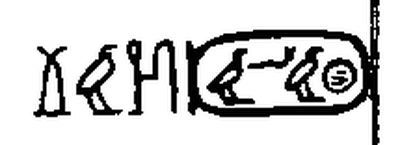
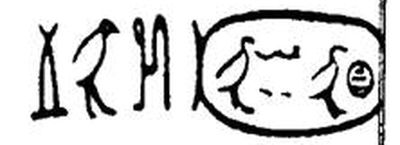
Perring's cartouche is different from Sitchins's. For example, the snake's tail ends up, while the Sitchins snake bends the tail down. The image of Sitchins looks more like a drawing of Vyses. But one thing is clearly visible: in both sources, Vyse and Perring, the small structure in the circle is three horizontal lines. Both images undoubtedly show a "Kh" and not a "Re". And while we can see that the small image of Sitchins on the left comes from the Vyses report, we can also see that his "enlargement" on the right is not an enlargement but a new image, probably drawn by Sitchin himself. same - and rigged! Sitchin did not find any fake, he produced one himself to get his hawk story.
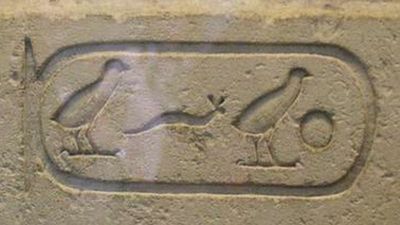
Cartouche of Khufu
According to Sitchin, Vyse believed that "Khufu" was written with a solar disk. And because of that, the forger had written it so in the room. But the Vyses diary explains what really happened:
On May 27, 1837, we discover the first cartridge of Khufu. In the days that follow, Vyse begins an analysis. And if one is able to read his writing, he discovers fascinating things. Yes, Vyse was not an expert in hieroglyphics. And yes, Vyse had with him the book "Material Hieroglyphica", which caused errors of interpretation. He expected the first sign of the cartridge to be a solar disk and wondered why it was not. He could not understand the "Kh", so he philosophered on this page of his diary about the possibility of writing a "Re" with lines instead of a dot.
He went so far as to copy the erroneous image of Wilkinson on the page of his notes. He also notes that this disc can also be written with a dot in the middle (the small circle on top) and that he expected one of these two writings. He also notes that he saw rather a circle with three lines. This is clearly a mistake of Wilkinson, yet a famous hieroglyphic expert. It is concluded that Vyse did not copy his graph of a book, he found something that completely contradicted a table of a famous academic book and did not know what to make of this discovery. It is interesting to note that nothing more has been discovered since the original "discoveries" of Vyse.
Know how to interpret cartouche
Source: Birch's Analysis of the Cartouches from Perrings "Pyramids of Giza" from 1839
A cartouche of "Khufu" was found on the south roofs of Campbell's chamber, and a cartouche "Khnum-Khuf" on the south wall of Queen Arbuthnot's chamber, located below. We can see that the two cartridges do not appear side by side. The writing style is certainly hieroglyphic, but it also contains characters that have not yet been translated.
Fix begins his interpretation:
In terms of direct and solid evidence, Khufu' association with the Great Pyramid rests entirely on the seemingly simple fact that there are cartridges in his name on the walls of the rooms hidden inside the building. However, the general controversy surrounding the pyramid extends even to the meaning of these marks, and the evidence is not as simple as it may seem. These cartridges are not the only cartridges in the discharge chambers. There are others, more numerous, marked "Khnum-Khuf". The problem is that Egyptologists do not know who was (or even what was) "Khnum-Khuf". As Breasted explained, the writing of these early dynasties "is in such an archaic form that many of the few fragments we have of this age are unintelligible to us." In addition, these cartridges are also found elsewhere, especially on Mount Sinai.
We are no longer in the question of authenticity but in that of interpretation. It is important to note that he admits (like others), that these cartridges are authentic, which poses a problem to him is their meanings.
Now let's quote Petrie: Another name has been found engraved on the blocks of the Pyramid, side by side with those bearing the name of Khufu. This other name is the same as that of Khufu, with the prefix of two hieroglyphs, a pitcher and a ram and it is variously made under the name "Khnumu-Kheops", Nh-Shufu and Shu-Shufu. The most plausible theory is that it is Khufu, and that the ram is simply a symbol of the god Shu put as determinative as the first syllable of the name. But against this hypothesis it should be noted that:
- The pronunciation was Khufu, not Shufu, in the early days
- That the first hieroglyph, the pitcher, is thus unexplained
- That there is no similar prefix of a determinant to the name of a king, in any other case among the hundreds of names and thousands of variants, known.
Petrie also says: "The only great royal inscription (of Khufu) is on the rocks of Sinai, there are two tablets: one with the name and titles of Khufu, the other with the king striking an enemy, and the Khnum-Khufu The name is found in five different places, the two successively inscribed names can not be coincidence, either two different names of the same king or two separate kings If that were the case, Khnum-Khufu should be the most important. " Fix also points out that, although the inscription "Khnum-Khufu" is more frequent than that of Khufu, the name does not appear on any of the lists of kings.
The Manetho king list indicates two pharaohs, Suphis I and Suphis II, the first of which, etymologically, connects "Raufu-Khufu" to "Shoufu" and "Shuphis" to Suphis. We have the other cartridge "Khnum-Khufu" which requires only the identification of the "Khnum" part. Garnier says Suphis II cartridges, called Num Shufu, shows himself co-regent with Suphis, he cooperated with him in the construction of the great pyramid; the two names being constantly found on his masonry with the mark indicating them together. (He refers to Osborn's Monumental Egypt Story, Vol 1, pages 279-281)
There is an argument then that the cartridges served for two co-regents. On the monuments bearing the name of Khnumu-Khufu in Giza and Wady Maghara, there is also the name of Khufu. It is very likely that the names were thus together, if they were co-regents, as their joint occurrence in the pyramid, and elsewhere, and we must therefore wait to find them together. Such co-regencies often existed at the time.
Max Muller thought that "Khnum-Khufu" represented a God. Fix also noted the association between Khufu and Hermes. He said, "A scholar (Stewart?) Says there was a god in Egypt called Khnemu who was the embodiment of the intellect itself." The alternate names for Khnemu were Khnum, and Chnuphis or Chnouphis which is etymologically similar to that of Souphis ".
"Khufu" is thus an abbreviated form of "Khnum-Khufu", which means "Khnum protects me". The god Khnum was the divine potter who made the works requested by Thoth. Thoth (or Djehuti) was the god of wisdom, the ruling intelligence of the universe, and was later known as Hermes, Mercury, and Enoch. Thoth-Hermes was the inventor of the arts and sciences, the protector of secret wisdom and an initiator. The name has been adopted by many initiates, known as "serpents of wisdom"; the caduceus or the stick of Hermes is intertwined with one or two snakes. Khnum was later known as Kneph or Chnuphis, who was represented by a huge serpent; he represented the divine creative wisdom and was the patron of the initiates.
It was also suggested that the presence of the Khufu and Khnum-Khufu cartridges inside the Great Pyramid and some of the masonry stones on the outside does not prove that it was Pharaoh Khufu of the Fourth Dynasty that had built it, it may have been named after the pyramid, rather than the other way around. The cartouche of Khufu was found on dozens of tombs and monuments in Egypt, some of them dating from later than the Fourth Dynasty.
This disparity between the arguments highlights the poor understanding of the events that took place during the Fourth Dynasty. We have the following possibilities:
- Khufu may have been named or associated with a god called "Khnum" or "Khnum-Khufu", but in this case why put a god's name in a cartouche?
- "Khnum-Khufu" or "Num-Shufu" were co-regents. Maybe "Suphis II" and Khafra were too. But here too why the cartridge does not exist in any of the lists of kings?
- The Aries and the Jug have a different and not literal meaning.
- The word "Khnum" or "Noum" means something that has not been translated correctly yet.






